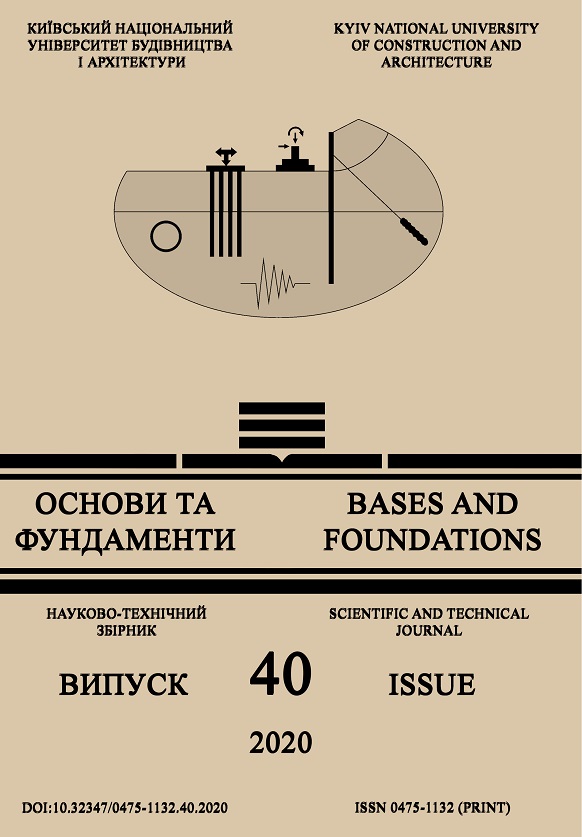Напружено-деформований стан підпірних стін в залежності від їх конструкції
Основний зміст сторінки статті
Анотація
У сучасному містобудуванні, в більшості випадків, при зведенні будівель і підземних споруд виникає негативний вплив нового будівництва на існуючу забудову. Як правило фундаменти нових будівель проектуються із більшою глибиною закладання в порівнянні з існуючими будівлями. В результаті робіт по екскавації котловану та подальшому влаштуванню несучих конструкцій підземних споруд існуючі будинки зазнають нерівномірних осідань. В стінах можуть з’являтись тріщини та відбувається порушення експлуатаційної придатності конструктивних елементів. Перед геотехніком виникає завдання визначення габаритів зони впливу нового будівництва, тобто ділянки, на якій можуть відбуватись негативні процеси формування напружено-деформованого стану. Для дотримання безпечної експлуатації існуючих будівель виникає необхідність достовірного прогнозу додаткових деформацій існуючих будівель і споруд, а також вибору раціонального рішення огородження котловану.
Проведено моделювання напружено-деформованого стану підпірної стіни котловану при різних діаметрах та зміні кількості рядів паль. Розрахунки напружено-деформованого стану захисних конструкцій спільно з ґрунтовою основою виконувалось за допомогою методу скінченних елементів для горизонтального навантаження на 1м.п. підпірної стіни (задача плоскої деформації).
Розвязувались 4 варіанти задачі:
В1 – підпірна стіна із паль довжиною 13,5м, діаметром 420мм, розташованих в один ряд;
В2 - підпірна стіна із паль довжиною 13,5м, діаметром 620мм, розташованих в один ряд;
В3 - підпірна стіна із паль довжиною 13,5м, діаметром 420мм, розташованих в два ряди;
В4 - підпірна стіна із паль довжиною 13,5м, діаметром 620мм, розташованих в два ряди;
Показано вплив збільшення діаметра паль в конструкції підпірної стіни на збільшення моменту інерції перерізу, що призводить до сприйняття більшого значення згинальних моментів.
Виконано техніко-економічне порівняння варіантів огородження котловану.
Виявлено найбільш раціональне рішення огородження котловану в даних умовах.
Блок інформації про статтю

Ця робота ліцензується відповідно до Creative Commons Attribution 4.0 International License.
Автори, які публікуються у цьому журналі, погоджуються з наступними умовами: Автори залишають за собою право на авторство своєї роботи та передають журналу право першої публікації цієї роботи на умовах ліцензії Creative Commons Attribution License, котра дозволяє іншим особам вільно розповсюджувати опубліковану роботу з обов'язковим посиланням на авторів оригінальної роботи та першу публікацію роботи у цьому журналі. Автори мають право укладати самостійні додаткові угоди щодо неексклюзивного розповсюдження роботи у тому вигляді, в якому вона була опублікована цим журналом (наприклад, розміщувати роботу в електронному сховищі установи або публікувати у складі монографії), за умови збереження посилання на першу публікацію роботи у цьому журналі. Політика журналу дозволяє і заохочує розміщення авторами в мережі Інтернет (наприклад, у сховищах установ або на особистих веб-сайтах) рукопису роботи, як до подання цього рукопису до редакції, так і під час його редакційного опрацювання, оскільки це сприяє виникненню продуктивної наукової дискусії та позитивно позначається на оперативності та динаміці цитування опублікованої роботи (див. The Effect of Open Access).Посилання
Osnovy ta fundamenty sporud. Zmina 1: DBN V.2.1–10–2009. (2011). Kyiv: Minregionbud Ukrayiny, 55 (in Ukrainian).
Bоyko I.P. (2006). Osoblyvosti vzaiemodii palovykh fundamentiv pid vysotnymy budynkamy z yikh osnovoiu [Features of the interaction of pile foundations under high-rise buildings with their foundation]. Osnovu i fundamenty: Mizhvidomchyj naukovo-tekhnichnyj zbirnyk. Kyiv: KNUBA, 30, 3-8 (in Ukrainian).
Vynnykov Yu.L. (2015) Modelnye yssledovanyya effektyvnosty razdelyte-lnyx ekranov dlya zashhyty ot vlyyanyya novogo stroytelstva. [Model studies of the effective-ness of soil-cement dividing screens for pro-tection against the influence of new con-struction] / Yu.L. Vynnykov, A.V. Vedenysov // Vestnyk Permskogo nacyonalnogo yssledovatelskogo polytexnycheskogo unyversyteta. Seryya: Stroytelstvo y arxytek-tura – Perm 2015 – S.51-63 - DOI: 10.15593/2224-9826/2015.1.04.
Zocenko M.L. (2013) Modelyuvannya napruzheno-deformovanogo stanu gruntovogo masy`vu zsuvnogo sxylu [Model of a stress-strain state of landslide slope] / M. L. Zocenko, Yu. L. Vy`n-ny`kov, M. O. Xarchenko, A. M. Vy`nogradova, O.V. Kostenko // Zb. nauk. pracz. Seriya: Galu-zeve mashynobuduvannya, budivnycztvo. –Poltava: PoltNTU. –Vyp. 3(38). – T. 1. – S. 160-169.
Turcek P., Sulovska M. (2007) Using the observation method for foundations of high-rise buildings / Geotechnical Engineering in Urban Environments – Rotterdam, – pp.419-422
Yakovlev I.I. (1997) Vzaymodejstvye sooruzhenyj s gruntom [Building interaction with soil base] / Yakovlev P.Y`., Bybychkov A.G., Bybychkov A.A. – M.: Nedra, 1997. – 464 s.
Capraru C. (2014) Numerical analysis of deep excavations and prediction of their influence on neighboring building / Capraru C., Adam D., Hoffmann J. // Numerical methods in geotechnical engineering - London: Taylor & Francis Group, 2014 – pp. 735-741 – DOI: 10.1201/b17017-132.
Chandrakant S. Desai, (1977) Numerical methods in geotechnical engineering / New York – McGraw-Hill, – 783p. – ISBN 0-07-016542-4.
